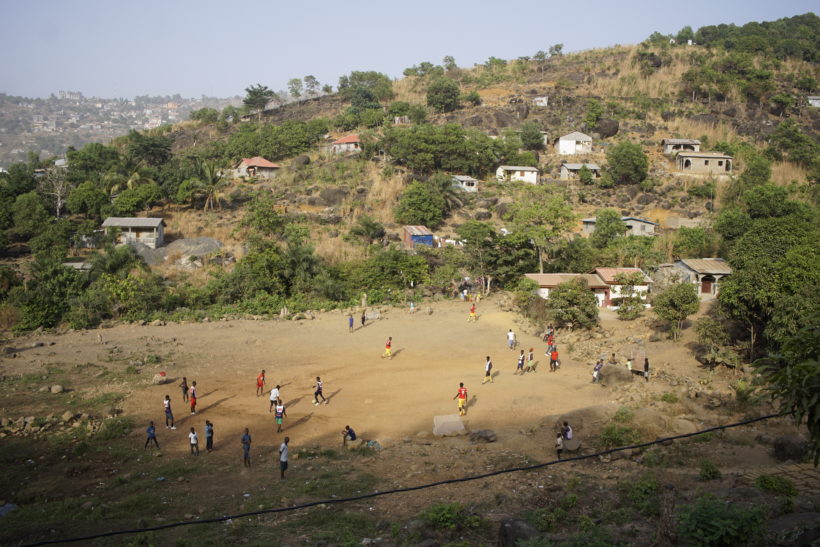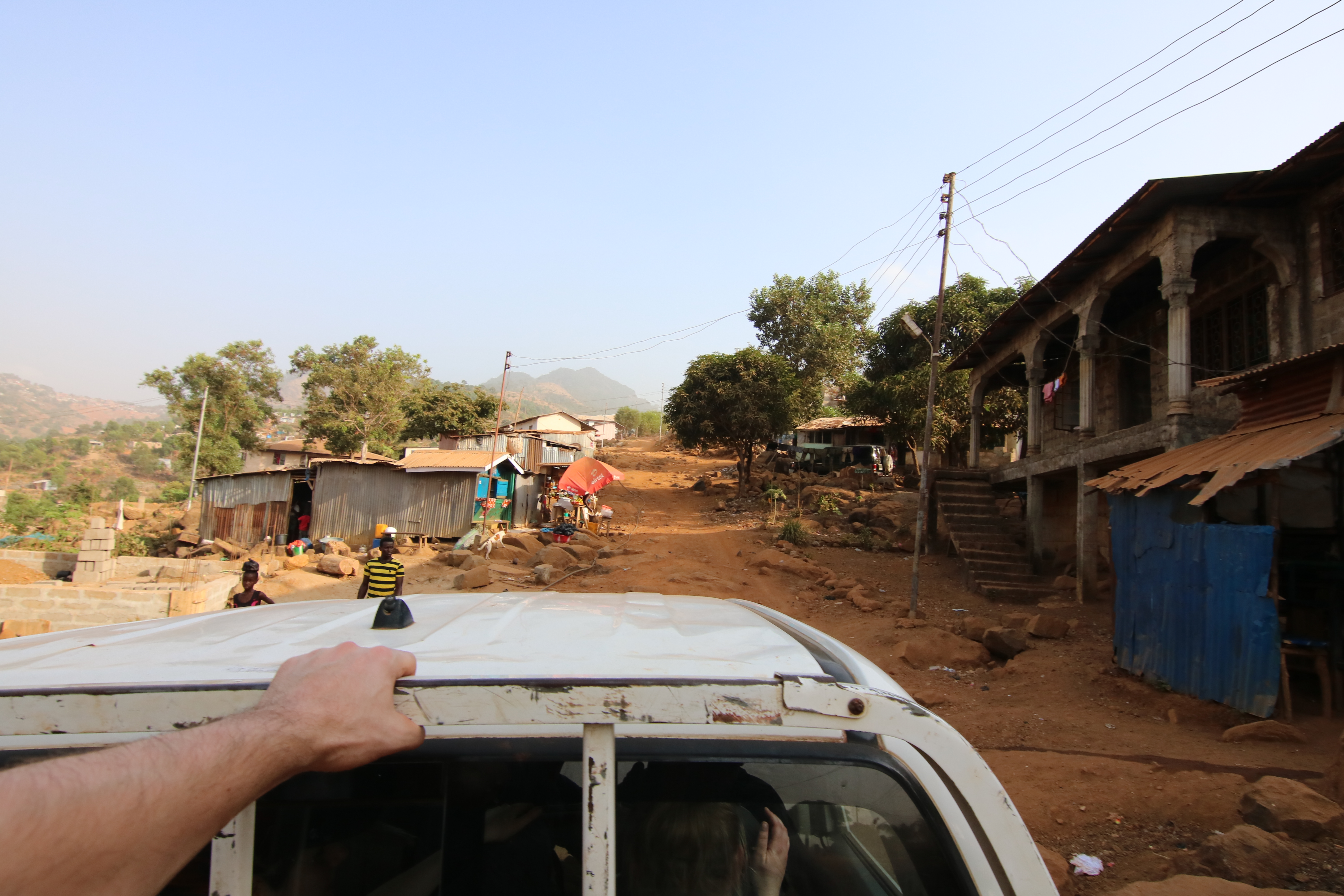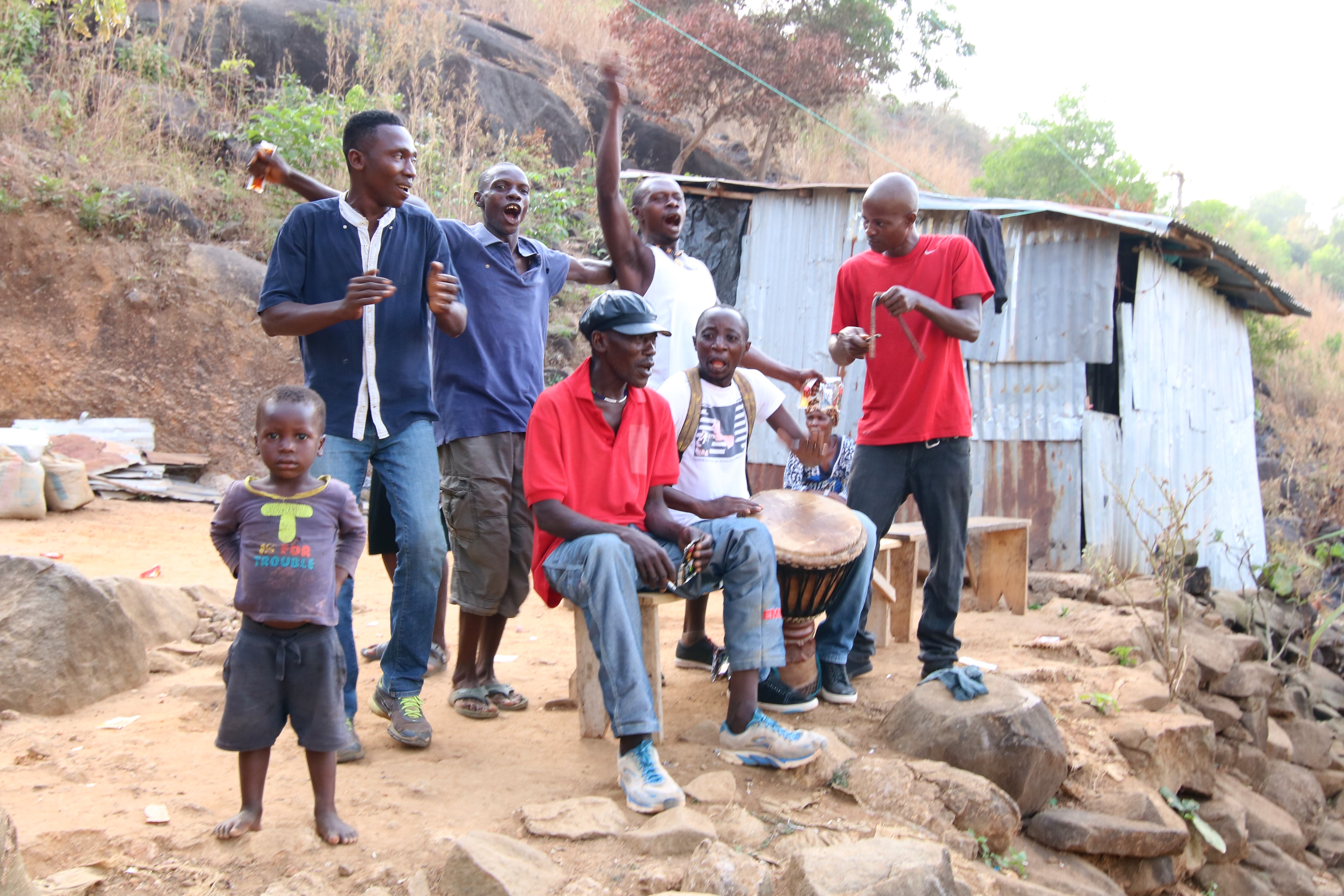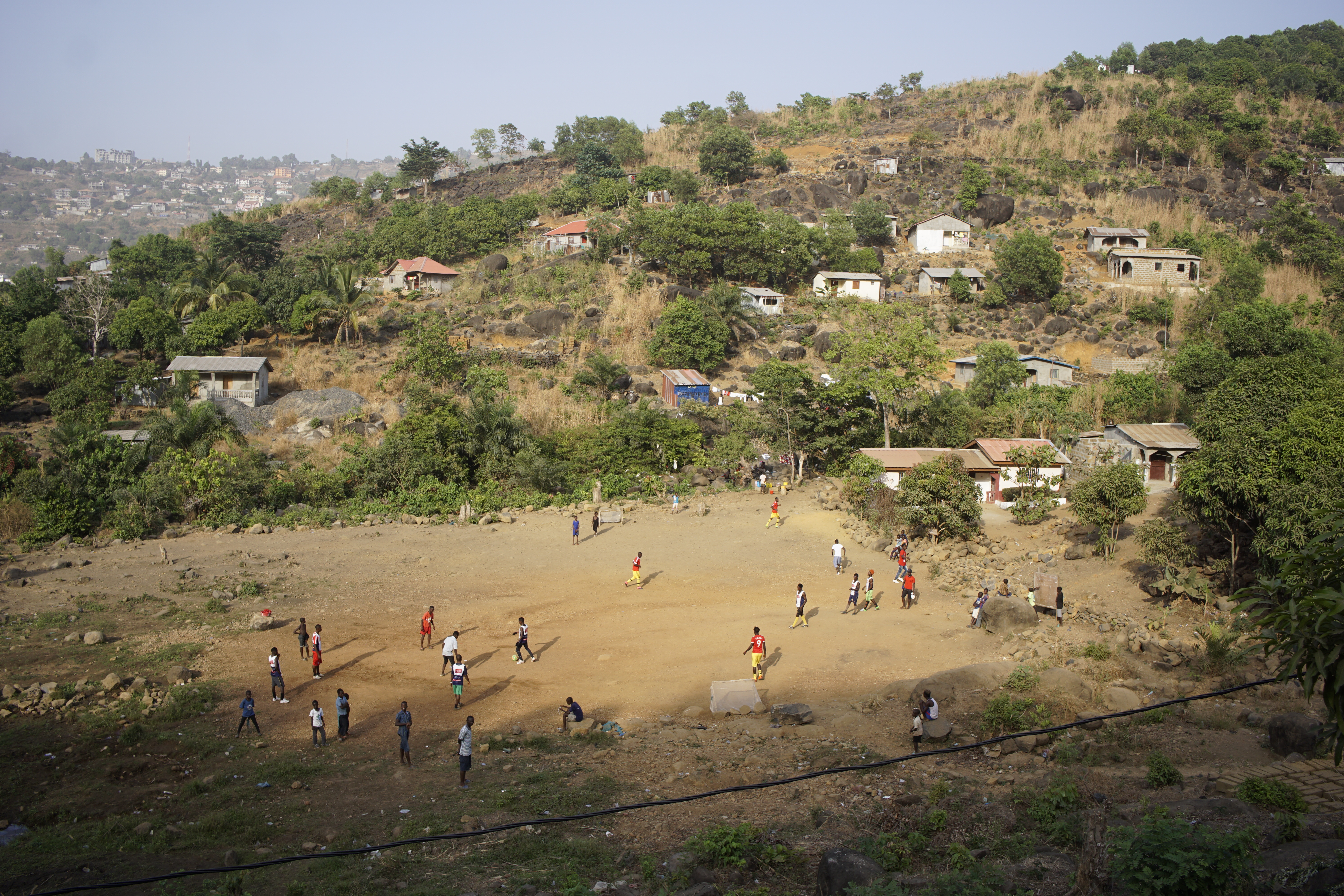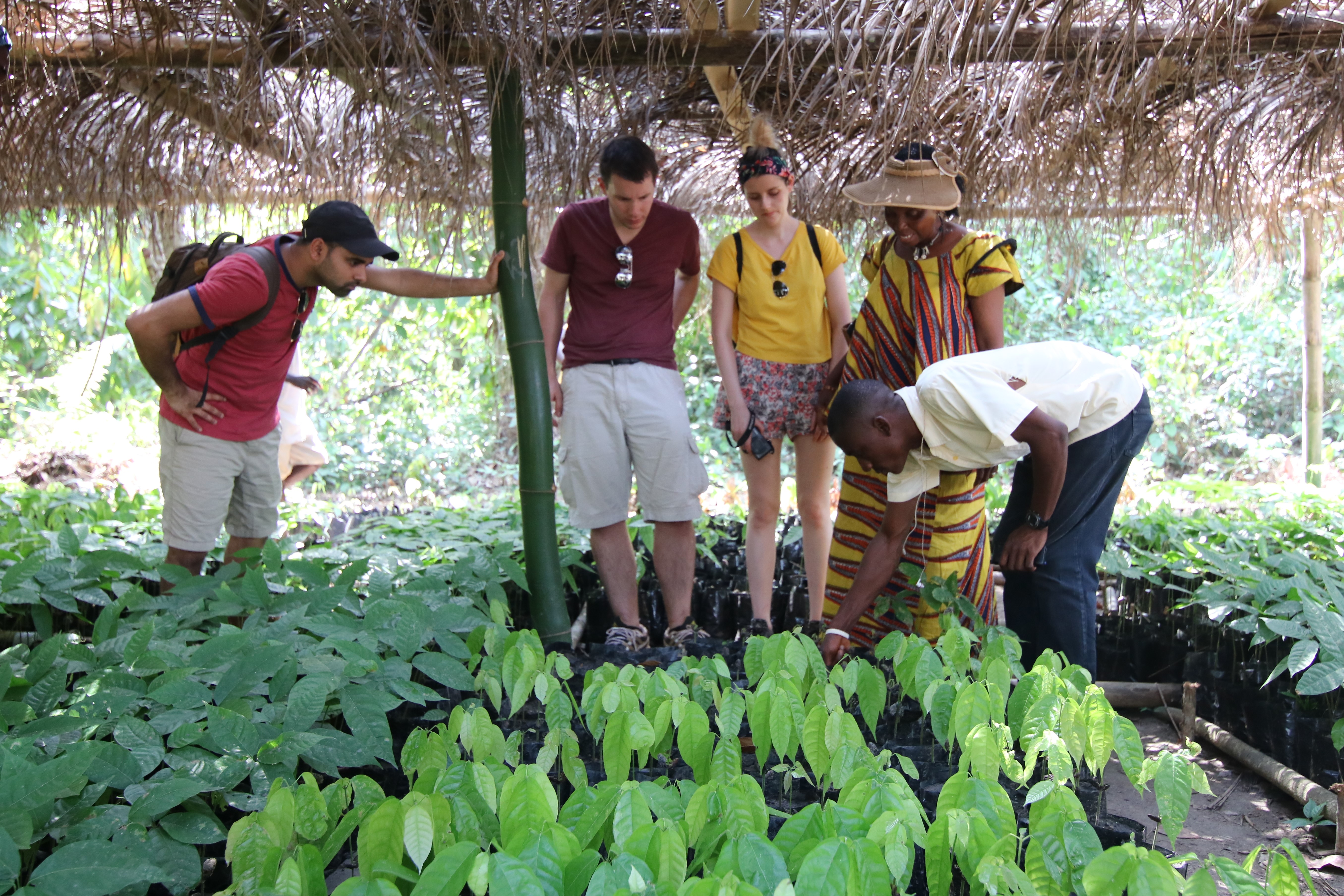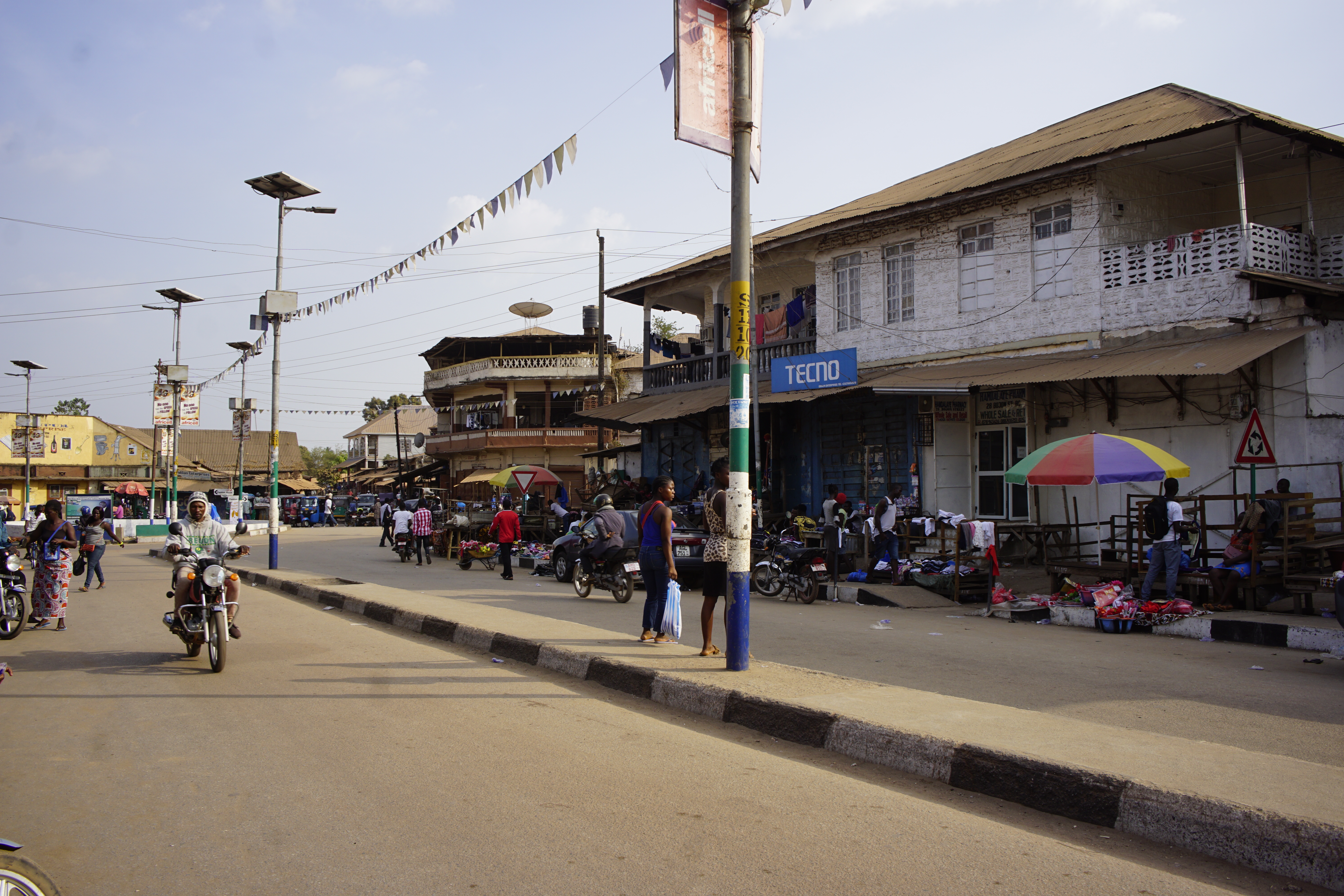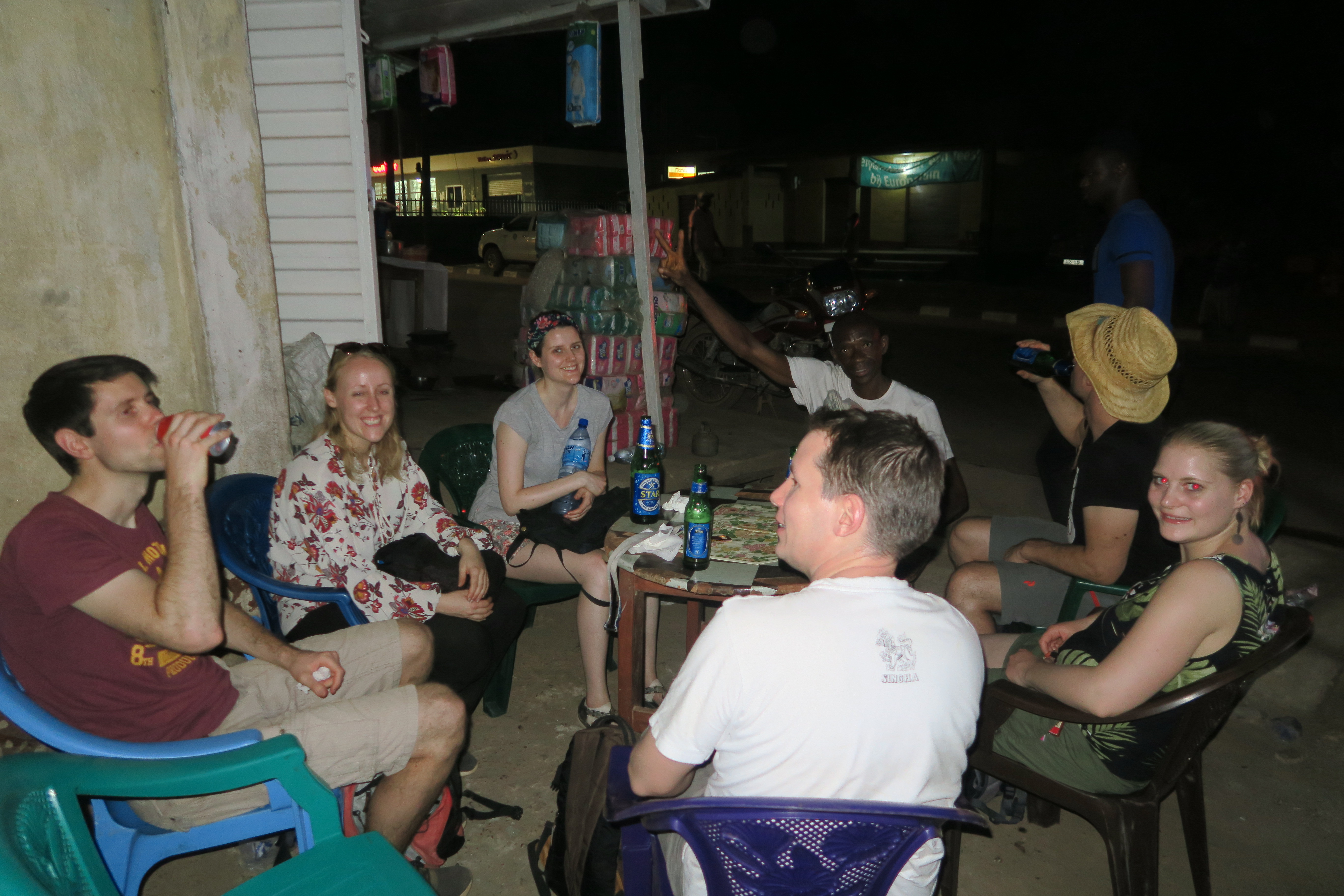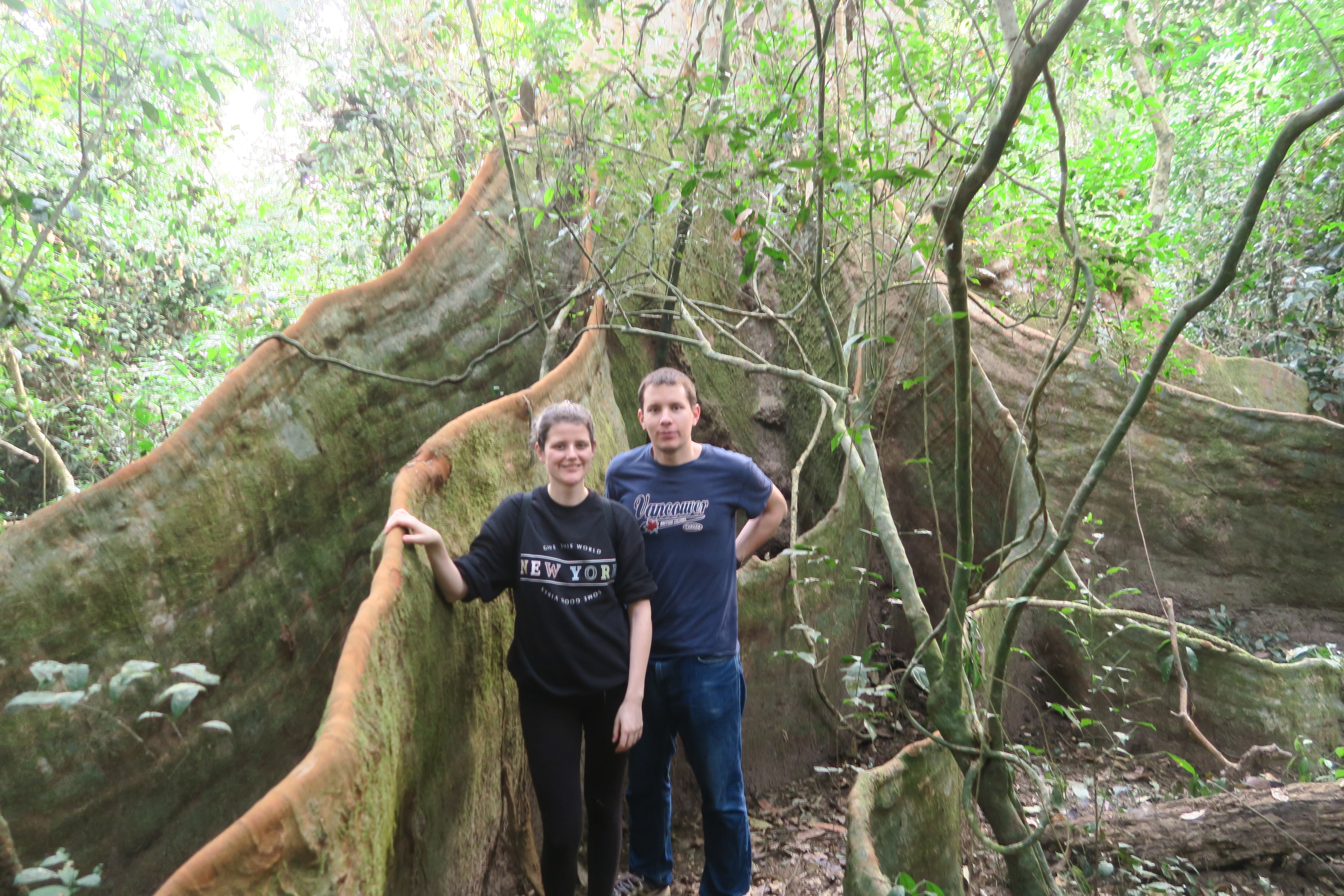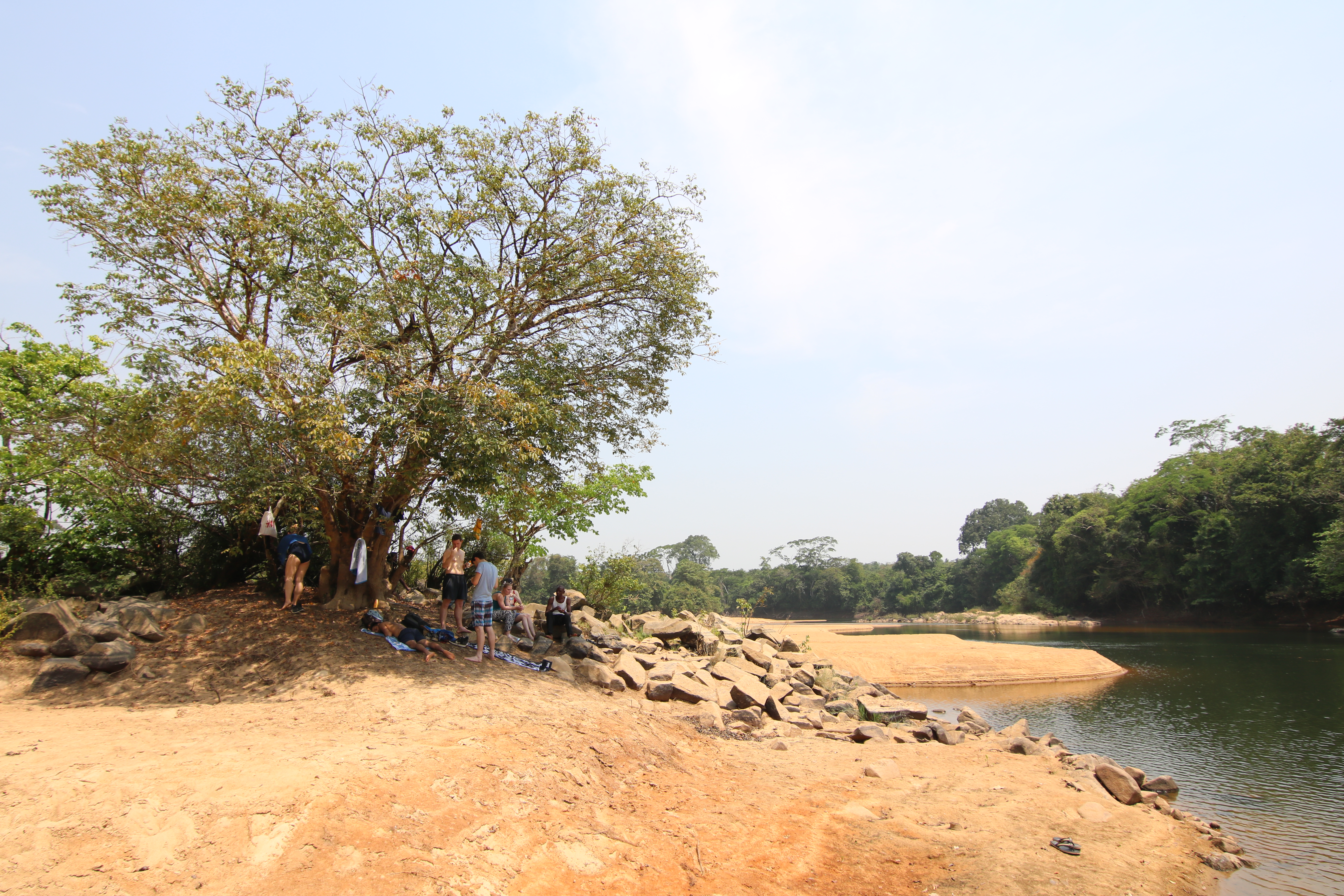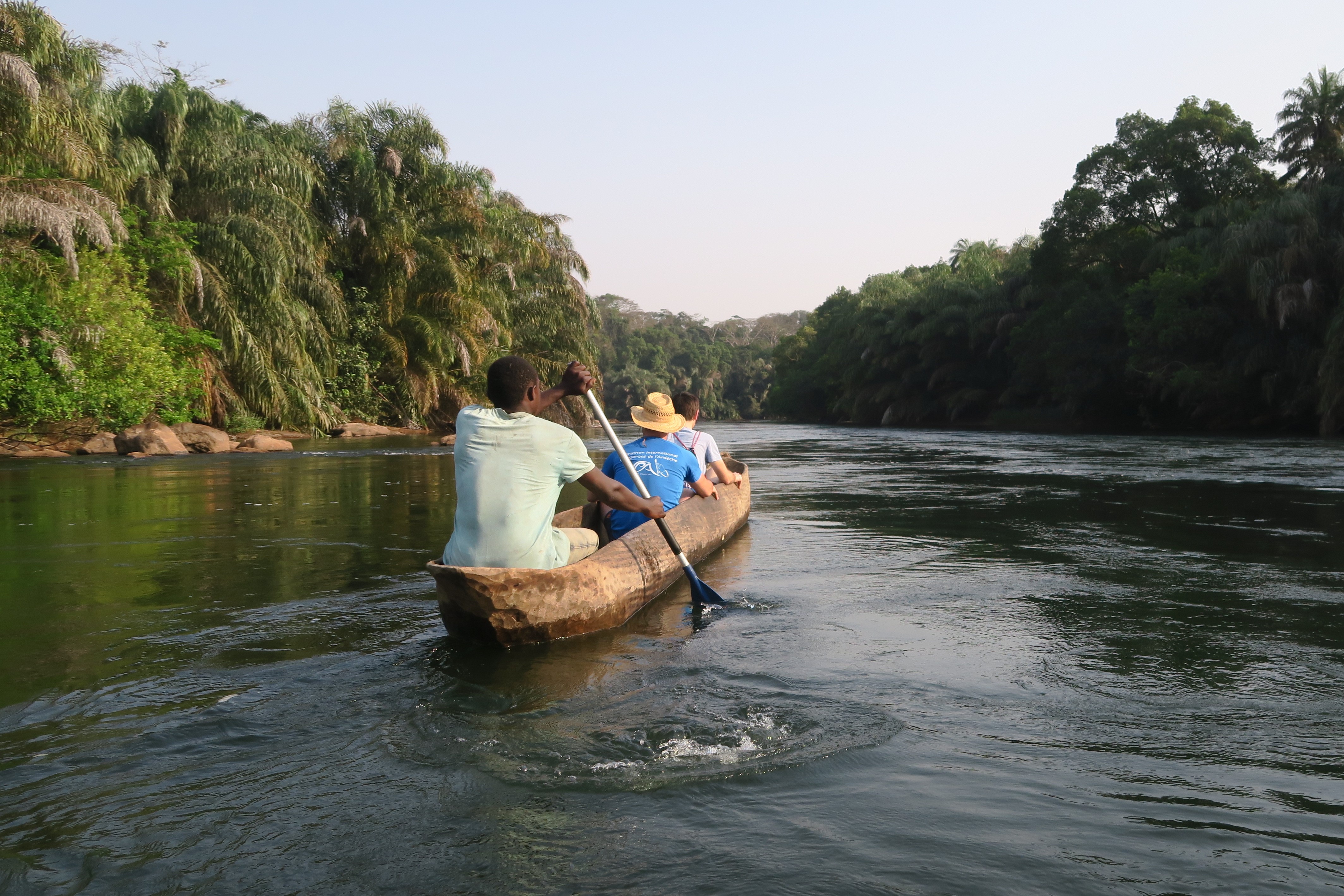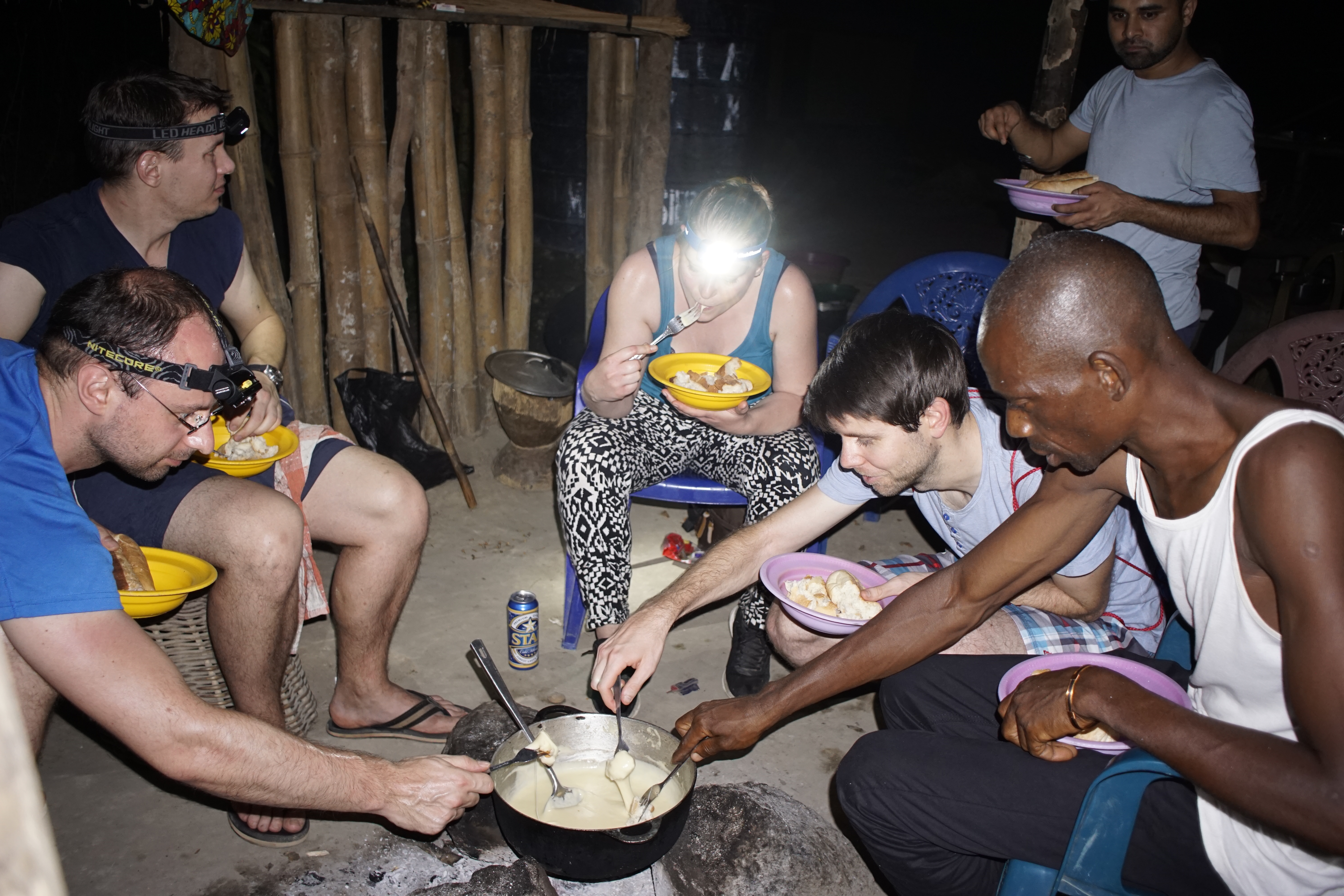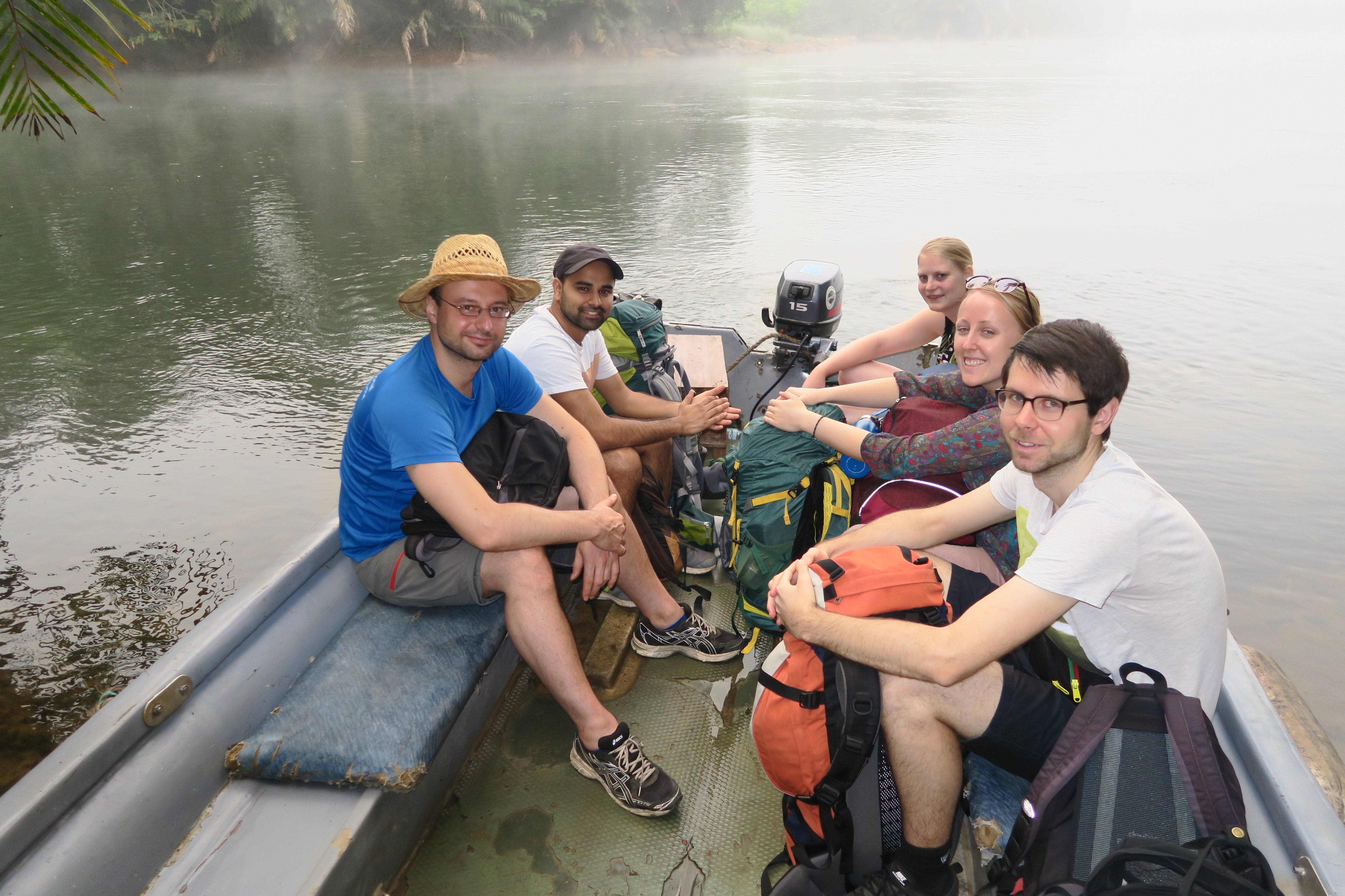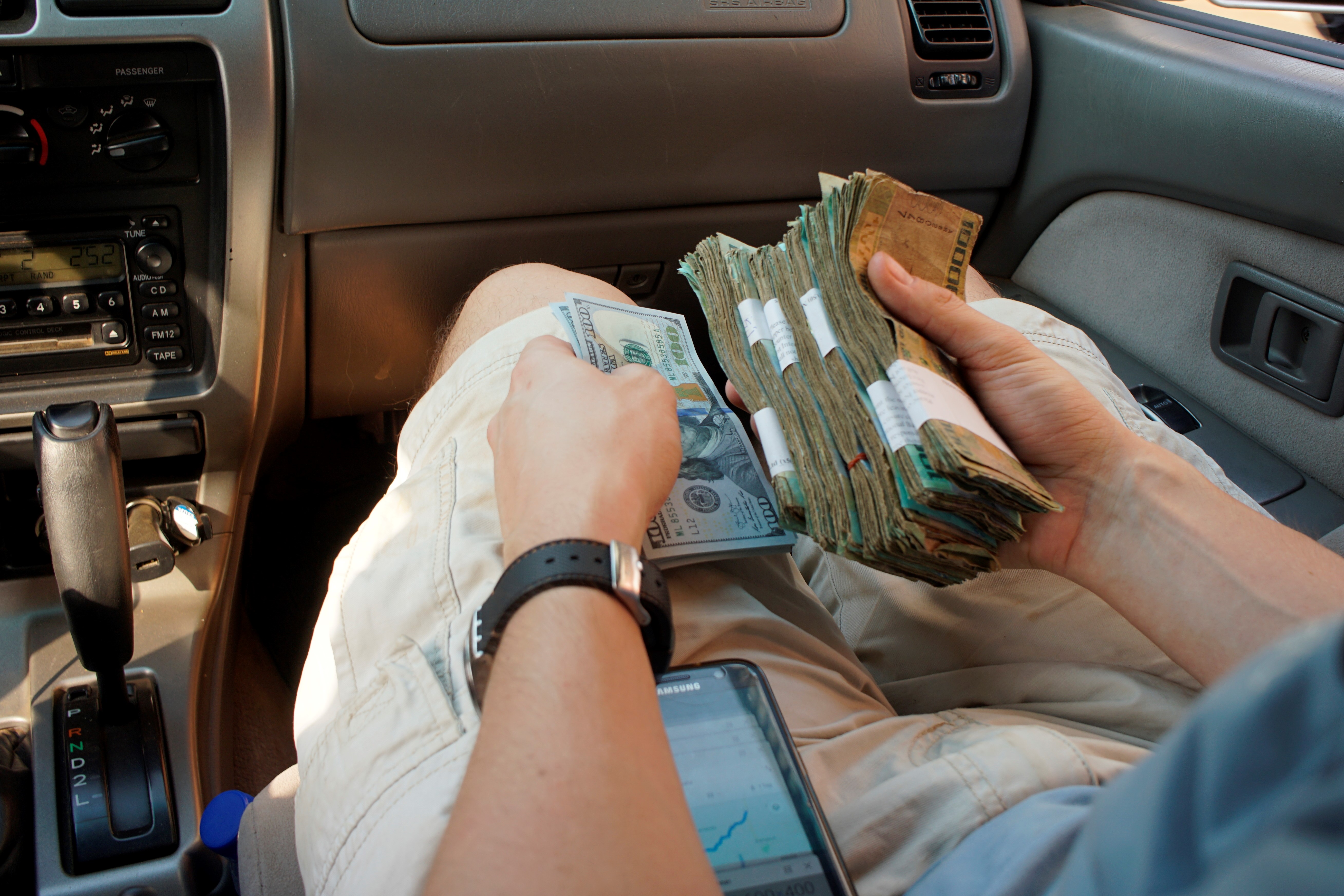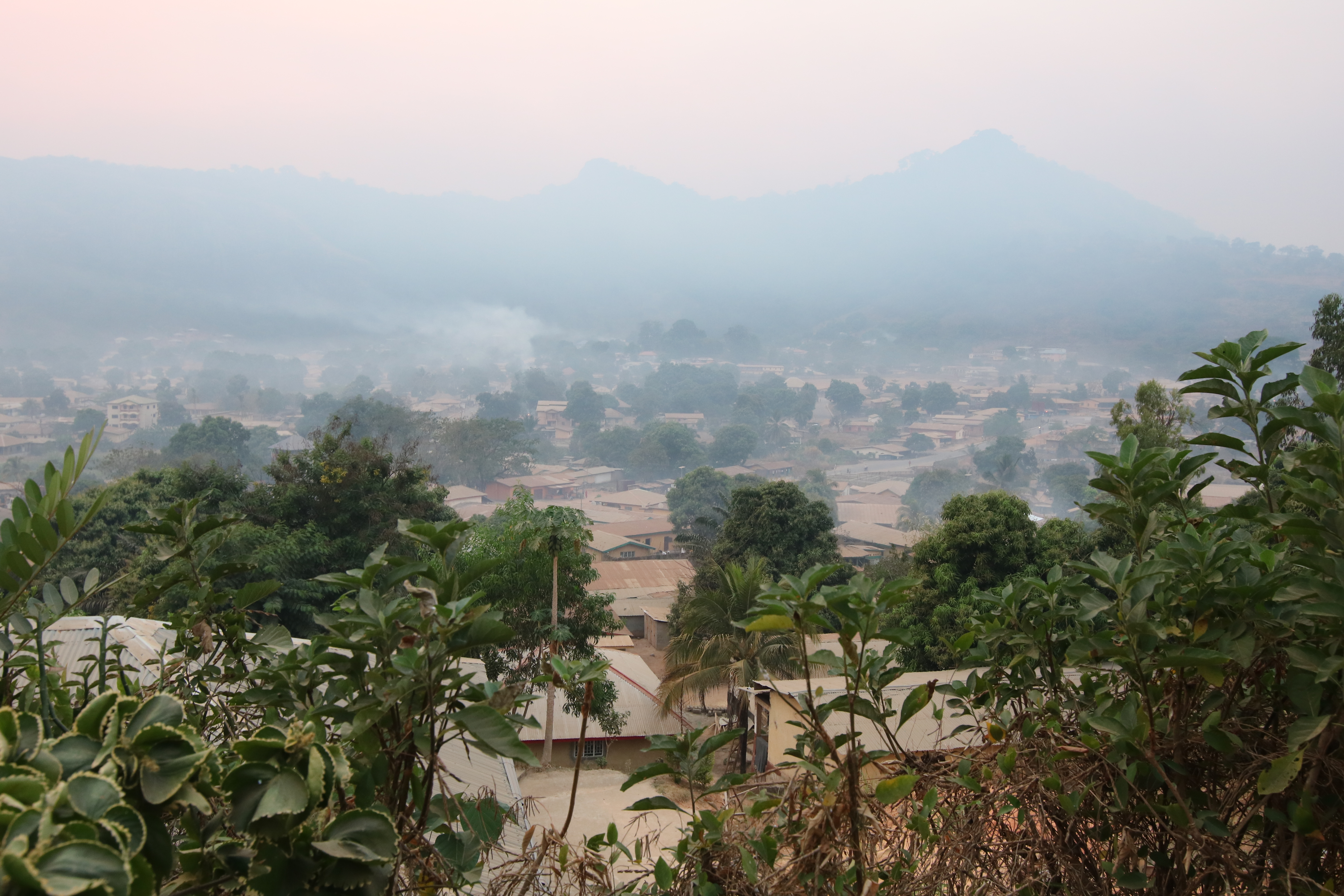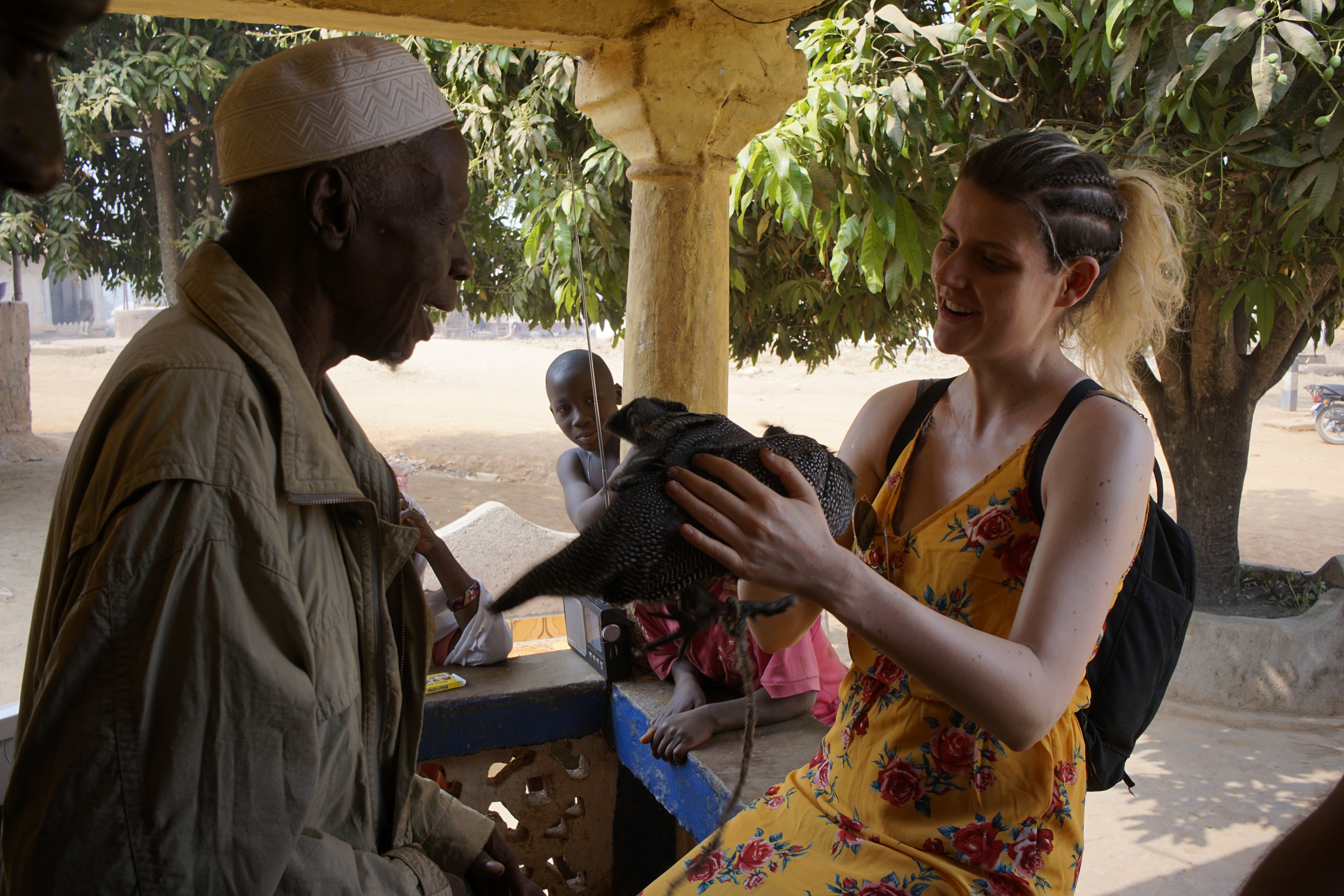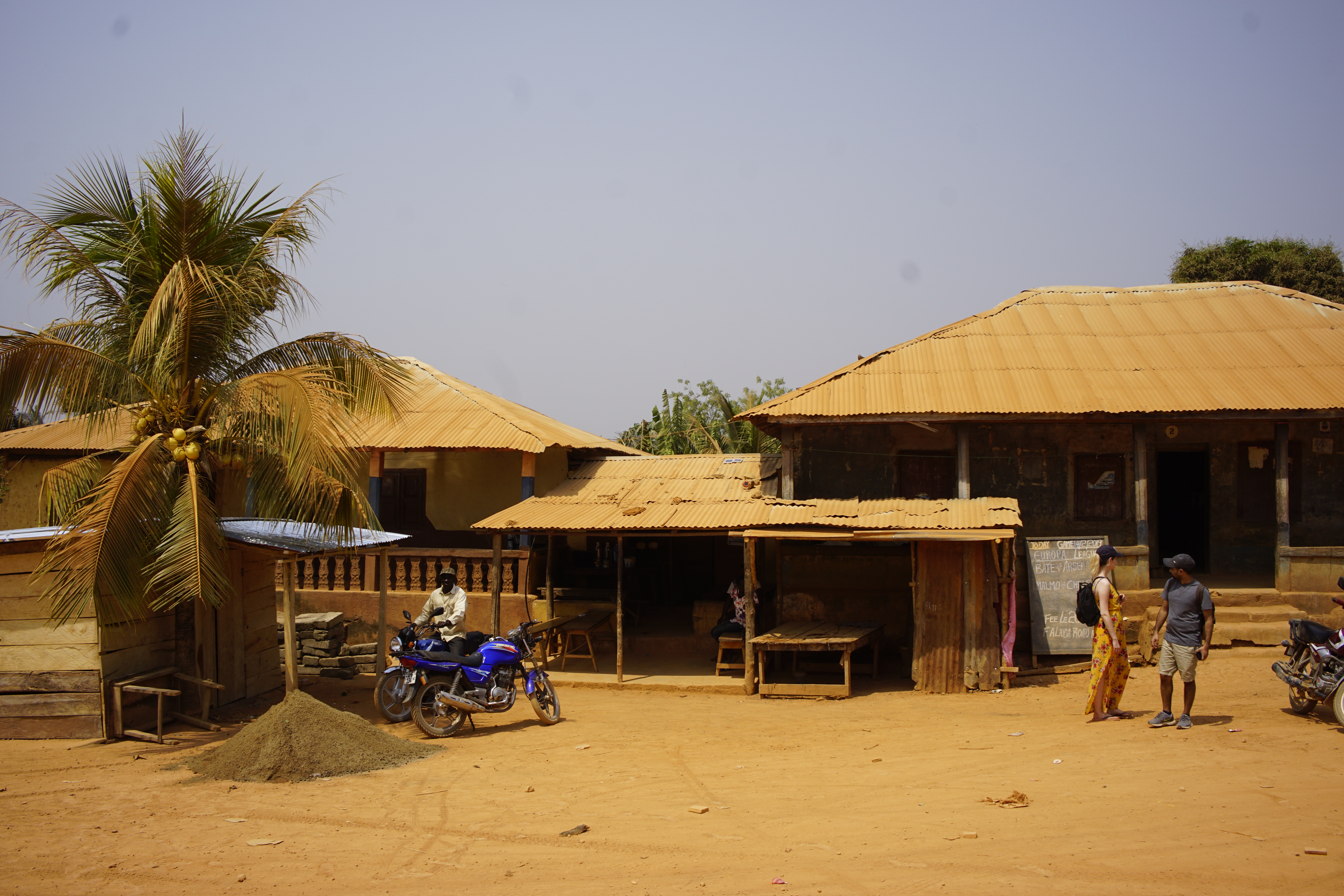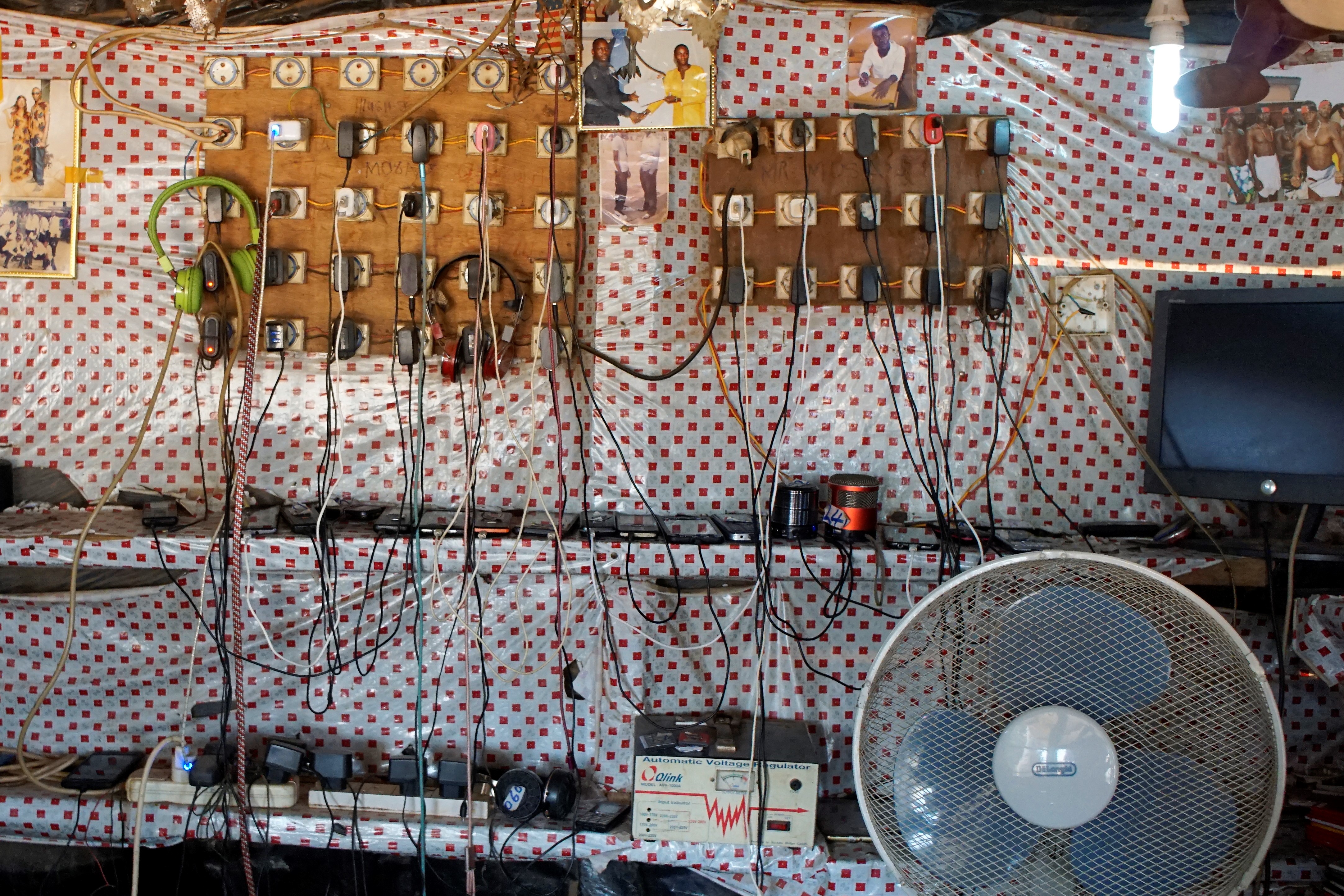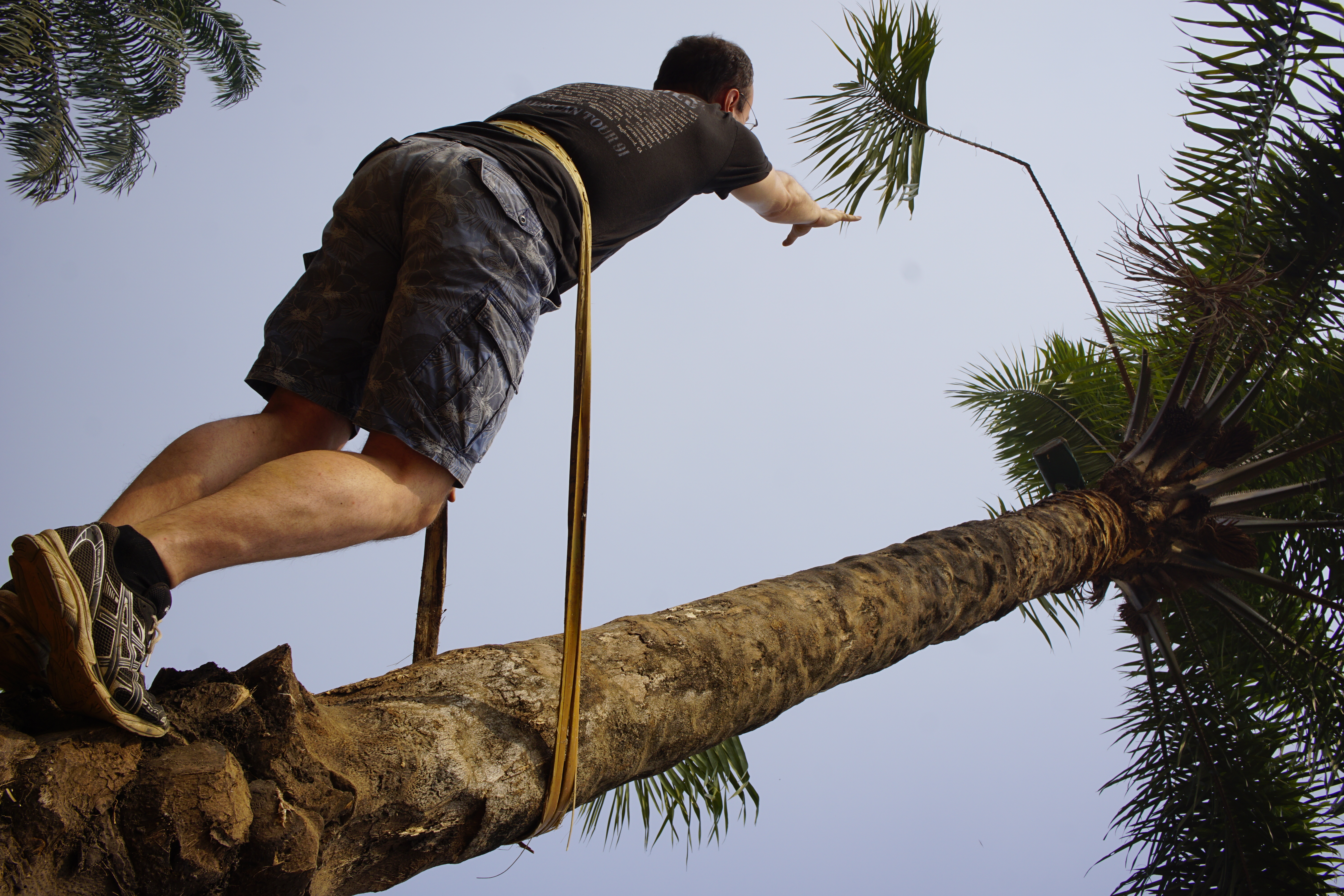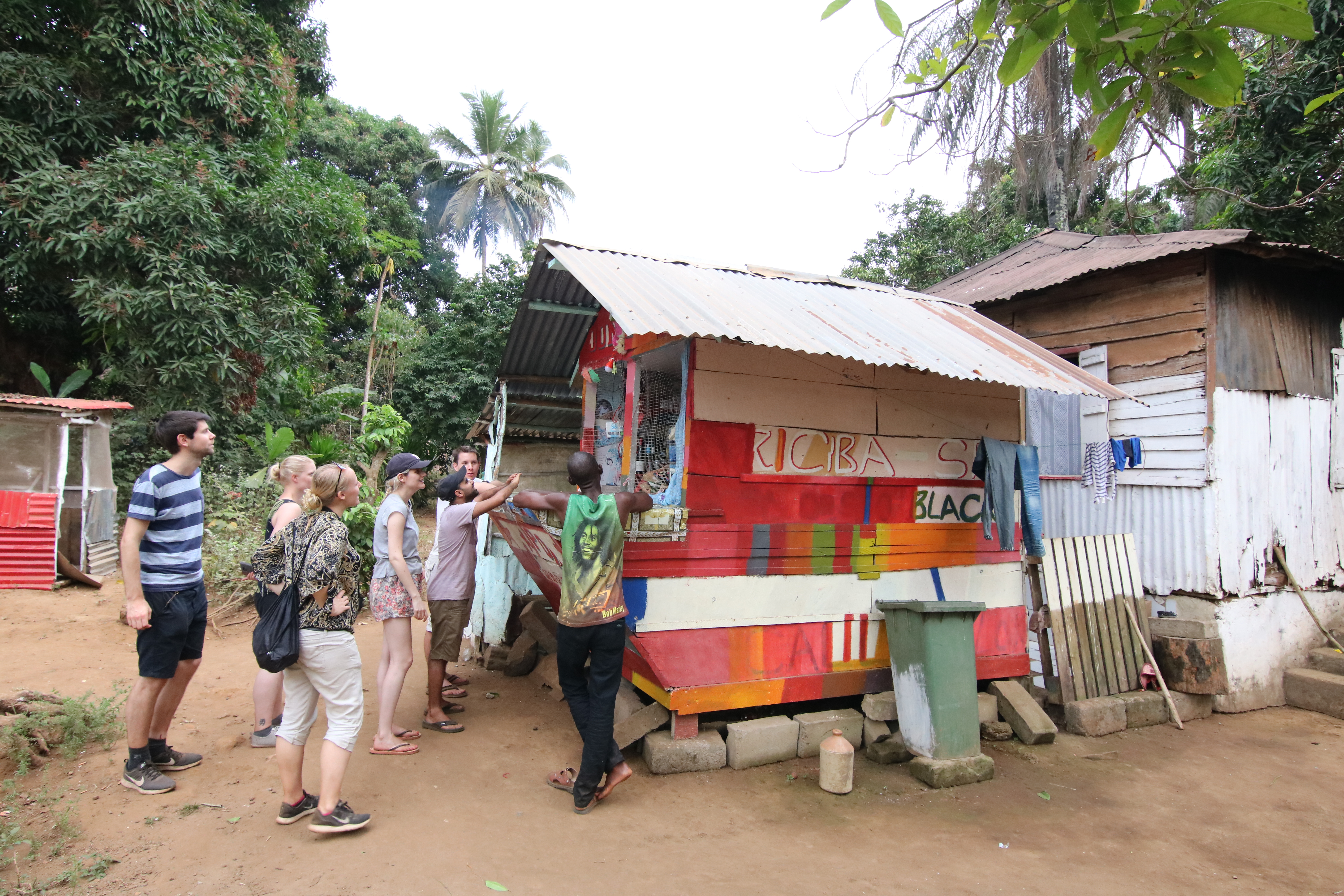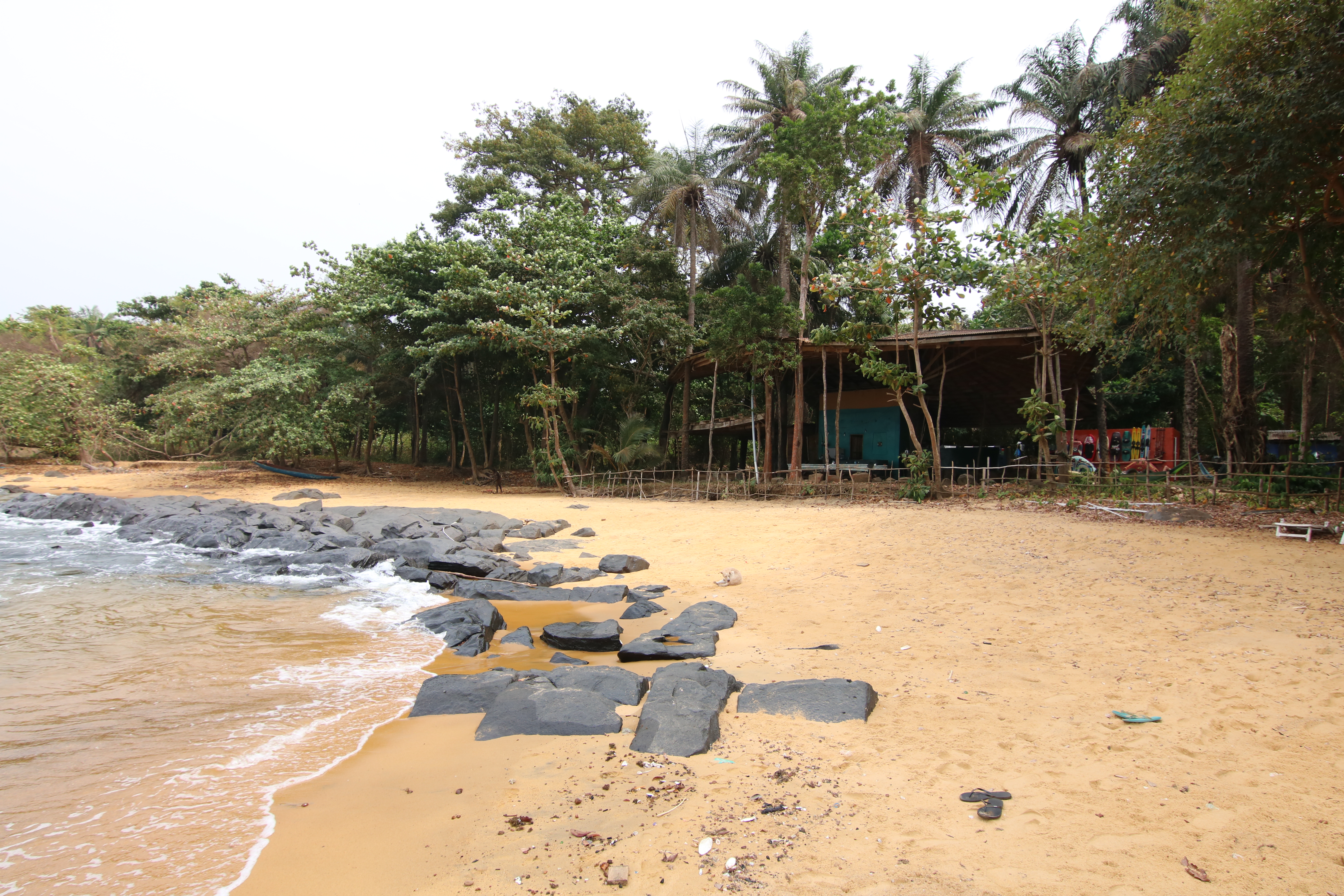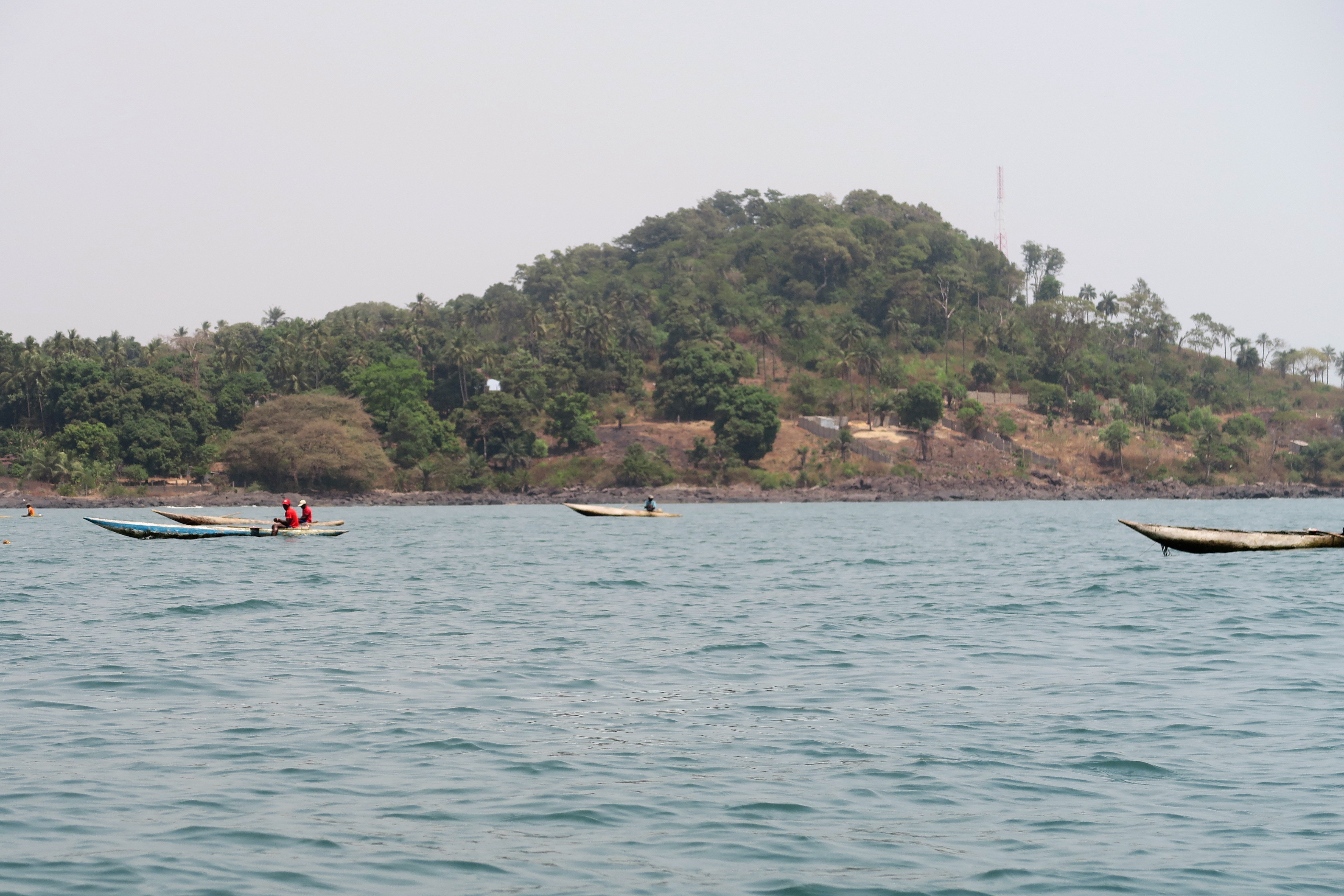Day 1
09.02.2019
VIP seats for football and a private concert in the backyard
Most of our friends and family most likely needed to google “Sierra Leone” to see where exactly we were about to travel to. (We save you the effort: it’s between Guinea and Liberia on the coast of West Africa, and one of the smallest countries of Africa, double the size of Switzerland).
Sierra Leone is definitely not a tourist hotspot, unlike Kenya, Namibia or South Africa, and that was the reason we wanted to take the chance to discover this country with IFIL. Nadine and Michael have already been in Sierra Leone two years ago; for their friend and co-organiser Sebastian, it was the first time, and also his first time in Africa. The rest of us have already been at least once in an African country, but not yet in Salone, as locals like to call the country.
On the first morning, we got to meet Allo, a 47-year old plumber and good friend of Nadine and Michael who had met him two years ago. He would accompany us on this trip, what we were very grateful for. After a stroll through Lumley, a neighbourhood of Freetown close to our hotel, we went to the Fourah Bay College, the oldest university of West Africa. At the faculty for mass communication, where students have classes in journalism, public relations and marketing, we had the chance to meet one of the teachers called Joshua. We sat down under a mango tree in front of the building and asked him questions about the media landscape in Sierra Leone.
“In terms of quantity, the media in Sierra Leone are quite diverse”, he told us. “but if you look at them in terms of quality, they are not very diversified as most of them rely on the same news sources.” Interestingly, radio plays the most important role in Sierra Leone – for two reasons: On one hand, it’s the cheapest to produce, to emit and to receive, you can use a radio with batteries instead of electricity and carry it with you. On the other hand, it’s not discriminatory; also illiterate people (around 50% of the adults don’t know how to write and read), can listen to the news. Also, radio stations often speak in the local language of the region, while newspapers only exist in English. Out of around 100-200 newspapers (there are more newspapers registered than actually produced), only three of them (!) are located outside of Freetown, so the newspaper remains a very elitist and urban media.
After this interesting introduction, we went to another area of Lumley and the place where Allo lives. He had promised to show us his newly built home. It was quite a walk up the hill under the beating sun; therefore, we were happy when Allo spontaneously stopped a little pick-up truck so we could hitchhike most of the way uphill, the ladies on the backseats, the guys on the truck bed (which sounds more comfortable than it was). When we arrived at his place, which is almost on top of the path that leads up another hill, we were greeted by a little informal welcoming committee who played the gumba, a traditional drum, and sang songs in Krio.
From his backyard, we had a perfect view on the football pitch down in the valley where two local groups played against each other, cheered by a colourful crowd of all ages standing and sitting around the pitch. We were glad we had carried a few beers up here and enjoyed our unexpected premium seats for this game. To get the full atmosphere, we went down to the pitch for the last half an hour of the game, followed by a bunch of curious kids who had already sneaked into Allo’s courtyard to observe the foreign visitors. Lucky enough to see the only goal of the game, we went back up the hill to join the guys dancing a little and singing a song Allo spontaneously invented for us. What a cheerful end for our first day!
Highlight of the day: Meeting a football player at Allo’s home and asking him how many goals he was gonna score today. The answer: “Three!” (They lost the game 1:0).
Day 2
10.02.2019
Partying next to a generator
Bo is the second largest city of Sierra Leone and our destination for today. For the next few days, we’ve rented two cars with drivers, Richard and Unisa, as travelling by public transport with a large group isn’t very handy. Also, it would allow us to be more flexible – a quality you definitely need in Africa. The ride to Bo which is 240 km away and only took us a bit more than 2 hours resulted in nicknaming the car of Richard “Speedy Richie”.
The racy ride was only partly the reason for our willingness to taste palm wine for the first time just after we had arrived in Bo at our hotel around lunchtime. After having checked-in, we sat down in the common area in the courtyard to have some water, and we started talking to a retired man sitting at the same table. Curious about what he was drinking, he offered us to taste some – “I have a lot down here”, he said, bent down and grabbed something under the table. Instead of a bottle, he put a whole canister of the white liquid on the table. We couldn’t help but laugh – this was indeed a lot, probably about four litres or so. We got some glasses and cheered to Salone, the sweet nickname of Sierra Leone.
In Bo, we visited some relatives of Allo and met his 25-year old son Husman, who showed us around and presented us his four-month-old twin girls. We walked around in the neighbourhood but after sunset, their neighbourhood was pitch black – electricity doesn’t run for 24 hours in Sierra Leone and some houses don’t have access to electricity anyway.
According to the World Bank, in the year 2016, about 20 percent of the population in Sierra Leone had access to electricity but it’s important to take into account that this only shows the average. The percentage of urban population having access to electricity is about 46% while as in rural areas it’s only 2.5%. But also in places with access to electricity, petrol or diesel generators are still used since the public power supply is unstable. Sierra Leone is among the countries with least access to electricity – in Ghana, for example, about 90% of the population has access to electricity (with 66% of the rural population).
To come back to the title of this blog post: On our official program for today it was written “Exploring nightlife in Bo”, so we went to look for a bar not far from our hotel. Sitting next to a load generator – but as Sebastian uses to say: “generator equals cold beer” – we had a few bottles of Star, the most popular locally produced beer. Initially, our plan was to go to bars or clubs afterwards, but our mission failed by pure laziness and cosiness. Without voice after having talked for a few hours next to a loud generator, but happy about another interesting day in Sierra Leone, we went to sleep.
Highlight of the day: This moment when you expect the guy to put a bottle of palm wine on the table and, instead, he lifts a whole canister.
Day 3
11.02.2019
Dancing with the spiders
“Welcome to Sierra Leone”, said Mama Samaih, an energetic lady in a traditional colourful dress. She invited us to sit down on benches and chairs under a big mango tree – all important meetings seem to take place under a mango tree in Sierra Leone, check blog post of day 1 – next to her house. From Bo, we had driven to Kenema, the third biggest city of Sierra Leone.
Nadine and Michael have met Mama Samaih two years ago on their first trip to Sierra Leone. She is the executive director of the organisation MOAWOMA Rural Women’s Development Association, and we came here to learn more about their activities as they are involved in different projects in multiple fields: agriculture, women empowerment, peace building, and education. “We offer training, help groups with logistics and administration, and consult different communities”, she said.
To get a better idea of their work, we went to visit one of their projects: a tree school. After half an hour of a pretty bumpy and dusty drive (but thanks to Speedy Richie, not a problem), we reached a little village in a forest. We were greeted by what seemed to be all the kids of the village who curiously looked at us and smiled. We also met the chief of the village and were taken to the place where they grow the seedlings, of course followed by a big crowd of villagers.
Mama Samaih explained that their organisation hands out polybags to communities in which they can start growing different seedlings such as cacao, coffee or mango by planting a seed in a mix of earth and different fertilizers. After half a year, the baby tree is big enough to be planted into the ground, which is done during the rainy season. The community we visited has about 250 bags in total.
“After five years, you will get the first harvest of the cacao tree”, she explained; a cacao tree lives up to 30 years. “Our products are all organic, so we don’t have a high quantity, but we have a high quality”, Mama Samaih said. The harvest is sold to the international market. 30% of the income of the harvest goes back to their organisation, so they are self-financed. During the time of planting but also afterwards, the organisation mainly supports the communities with their expertise. One important method is the companion planting, the planting of different crops in proximity for mutual benefits, such as providing shadow for other plants, fertilizing the ground by the falling leaves, and maximizing use of space, all in order to increase crop productivity. Our next goal is to teach communities how to produce cacao butter themselves”, Mama Samaih said, “so that we can add value and work our way along the production chain.”
We also got to see how palm oil is produced, another important traditional crop of Sierra Leone. First, the palm fruits are cooked for one day and need to cool down for another day. Then, the berries are put into a concrete pool and smashed and ground to extract the oil. The oil floats on the surface and can be skimmed. Sierra Leone uses palm oil for the local market as well as for export. The leftovers such as the skins etc. are used as food for animals or as fertilizer for the fields.
During the whole stroll, we were accompanied by a group of women from the village dancing and singing for us. Our guide Allo started singing with the kids. It was not the first time that non-Africans have visited, but usually, it’s business partners or NGO, and not tourists.
After a nice late lunch back in Kenema, we set off to our next destination: Tiwai island. We arrived around 9 pm, left our cars at the village and transferred to a boat. Accompanied by a sky full of stars, we were taken to the island where a delicious dinner – rice, chicken and groundnut sauce – awaited us. Our accommodation this time consisted of tents. Since it was already dark, we couldn’t see that much of the jungle around us, but one spider phobic member of our group realised it quite quickly when she found herself face to face with an eight-legged, hairy creature the size of a human hand in the bathroom. As the group knew about her dislike regarding these animals – even though she has two reptiles as pets at home – no one was too worried when hearing her shout and fell back to sleep.
Highlight of the day: A chicken eating a chicken – or at least the fried version of it as we left the left-over bones of the delicious lunch in our plates close to the ground.
Day 4
12.02.2019
Fondue in the jungle
Ready for a day full of adventures! Tiwai Island is a wildlife sanctuary and was established in 1979 as a research centre by leading primatologists. It is host to 11 primate species, over 135 bird species, and numerous butterfly species. Many scientists come here to do research about monkeys, birds, crocodiles or pygmy hippopotamus. The chances to see the first two are bigger than the latter two, nevertheless we set off at 7 am for a guided tour through the jungle with our hopes up.
Divided into two groups with its respective guide, we took different paths through the thick jungle and got to spot different types of monkeys, such as Diana monkeys and black and white Colobus, a few birds and many interesting looking plants and trees. We learned about the medical benefits of some of them and were impressed by the knowledgeable guide who knew all the botanical names of the plants.
After breakfast and some rounds of table tennis – yes, there is a table tennis table in the jungle! – a guide accompanied us to the beach. What we thought would be a ten minutes stroll turned out to be a 45 minutes hike through the jungle again. But it was totally worth it: We reached a large sandy beach with nobody around. “Are there any crocodiles in this part of the river?” we asked the guide. “No, no”, he said. “And are there any hippos?”, someone else asked. “Well I don’t know”, the guide answered smiling. We weren’t quite sure whether this was just a joke or not, but as we were feeling hot after the hike, we jumped into the river anyway. What a refreshing joy! And aside from some fish, thankfully there was no other animal joining us in the water.
The refreshment didn’t stay for long as we had to hike back but since now we were quite hungry, we probably walked faster and arrived at the camp in time for lunch. Our last attempt to spot a croc or hippo we made in the afternoon by taking a boat trip down the river. There were two little boats and – to our surprise – a real logboat as well, made from a hollowed tree trunk. In the beginning, the river was very calm, but it was moment our boat drove straight into a rock we lost confidence in our captain.
It didn’t get better the next ten times and we hit rocks every now and then. We also managed to get hit by a branch of a tree which made Nadine fell backwards on the boat. The other groups saw this incidence and couldn’t help laughing. Luckily, she didn’t hurt herself but as a result, we had some spiders in the boat now who had fallen off the tree. Guess who’s the spider phobic member of our group…
We learned that our captain was actually a volunteer which explained his lack of experience. But he didn’t give up and even jumped into the chest-high water to pull our boat over the rocks. After getting used to his unconventional driving style, we managed to relax a bit and enjoy the incredibly beautiful scenery and the sunset. We made some stops at which the main guide Bobo explained us different types of plants and showed us how they make palm oil.
We all made it back safe and sound – this adventure was definitely one of the highlights of the trip so far. The dinner was the cherry on the cake: Sebastian had taken two packs of fondue from Switzerland so we asked the staff whether we could use their fire pit and a pan to make our Swiss dish. We had bought bread before coming to the island (just the Fendant was missing…) so we enjoyed a delicious fondue in the jungle. Some staff members and Allo tried fondue as well. Allo’s comment: “It’s very good. But I think it would be better if we would add some meat or fish.”
Highlight of the day: Surviving eating raw cassava after realizing it’s the same as manioc (which is toxic when consumed uncooked… By the time of writing, surprisingly all group members were still alive).
Day 5
13.02.2019
How to become a multimillionaire
This morning, we felt a little bit like we’ve been kidnapped. After a night of negotiations about the final price of our stay which ended up in a heated discussion between Nadine, Michael, Sebastian, Allo and changing discussion partners from the island, the conclusion finding mission was postponed to the following morning.
Yet, it took another few hours during which there was a moment we all sat in the boat, almost ready to just drive back to the mainland ourselves. This option seemed to scare off our negotiation partners because one of them stepped on the boat and said he had to take the fuel canister to fill it up. We reacted quickly but not quickly enough. Even though we insisted that there was enough fuel left, the man managed to take away the canister and we were stuck on the boat without even the possibility to drive back ourselves (even though that might not have been a good idea anyways as none of us had proper experience of driving a boat, even less on a river we didn’t know and which had a lot of big rocks (read the blog post from the previous day!).
We finally got released from hostage and were taken back to the main land with a boat driver who had brought back the lacking fuel canister – probably not with more fuel in it, since there is no gas station on the island… We tried to take this situation as an intercultural learning process and part of the African experience.
Today we had to make quite a lot of distance, up north to Kabala. On the way, we also needed to exchange 600 Dollars to Leones which resulted in a fifteen minutes long procedure – not for negotiation or registration, but for counting all the money: We received 5,4 million in cash and got a little rubbish bag for free to store the money. (Exchange rate: 1 Swiss Franc is worth about 8600 Leones…)
In Kabala, we had a late meeting with representatives from different organisations, such as Centre for Youth Advocacy and Assistance (CYAA), World Conversation Society or a woman empowerment association. The main topic of our conversation was sustainable tourism, but they also gave us an insight into their different activities.
Margret, a radio journalist and member of women’s association, told us about her engagement to reduce female genital mutilation. FGM is widely practiced in Sierra Leone (as well as in other countries in Africa and the Middle East) and is a traditional initiation for girls in order to become a woman. “It is very difficult to change such an old tradition”, Margret said, especially since the whole village usually pays for the FGM for the girl (which costs about 500’000 Leones), and the family also receives gifts. Would they decline the offer and saying they don’t want to have an FGM initiation, they would be socially outcasted by society.
Margret said with the association they try to educate the women about the negative health consequences of FGM and they try to push for a national law with which the FGM should only be allowed to conduct with the consent of the person, and only at the age of 18 years. Now, it’s often practiced when the girls are young teenagers.
Turay from the World Conservation society talked about the importance of taking care of the environment which is not only important for the country itself but also for tourism as Sierra Leone has a lot of beautiful outdoor activities to offer. “In order to encourage sustainable tourism, we need to take care of our nature, stop deforestation and protect animals”, Turay said.
We learned a lot about other activities such as timber business or peace building projects among young people from different ethnic groups. In the end, we also gave an insight into Swiss culture. The participants asked whether Switzerland also has different ethnic groups, and they were surprised to learn that we have four different languages and a federal system which empowers regions. We also explained that tourism is one of the main incomes for the country and we agreed on the fact that Sierra Leone has a big potential for tourism, too.
Highlight of the day: Successful escape from the island.
Day 6
14.02.2019
Off the beaten track – literally
The great thing about trips with IFIL is that you get to discover places you would never be able to see as a regular tourist. That’s what we did in the Northern part of Sierra Leone as well. After a night at the beautiful guesthouse “Kabala Hill View”, we set off to Sinkunia – theoretically only 40 km away from Kabala but because of lack of an asphalted road, a 1,5-hour drive to reach the village where Allo was born and raised.
The bumpy drive was totally worth it: Because of Allo’s popularity, we met what felt like half the village and got invited to see some houses and also a kindergarten school, financed by UNICEF. We also met Sidiake Mansaray, a relative of Allo and a respected elderly. He was particularly pleased by the view of the blond girls of the group and we got a marriage proposal. Luckily, instead, he symbolically offered us a chicken and put it straight in the hands of the only vegetarian of our group. During our stroll through the village, we also saw a little shop called “Telecenter” where you could charge your phone since not all the houses of the village have access to electricity. We asked how much it costs to charge a phone: 1000 Leones, which is about 12 Dollar cents.
This was also the day we became experts of palm wine production: On the way to the village, we’ve seen a guy who had just “harvested” two canisters of palm wine and showed us how to use a customized wooden hoop to climb the palm tree. Of course, we wanted to try it as well! But as no one of us reached the top of the palm tree to take down the canisters, we just ended up buying three litres of the palm wine he’d just collected. You can’t get it any fresher – the taste was beautifully sweet and refreshing, the palm juice hasn’t had time to ferment yet. It would do so quickly as we would realize the next day… (check the next blog post).
From Kabala, it was quite a long way to Freetown. Thanks to two smokers in the group as well as an always hungry street shopaholic, we regularly made stops, tasted different snacks and saw some new places. At night, we reached our hotel Ocean View in Lumley – but just for one night, as the next day already a new trip awaited us.
Highlight of the day: In a night club where we had a lunch break, Sebastian said to the waitress: “A beer, please” She answered: “Fresh milk?”
Day 7
15.02.2019
Exploding palm wine
Today, we went to Dublin. No, not the capital city of Ireland, but a little village on Banana island. The past days we’ve seen loads of different places, met many new people and learned a lot about Sierra Leone. Time to take a rest and process the information. The plan was to spend a relaxed day on this island a 20 minutes boat ride away from the mainland.
We stayed at Daltons Banana Guesthouse, a beautiful spot right at the beach. Before jumping into the sea, we went on a historic tour through the village with Eric, the deputy chief of the island. Banana island was one of the main slave trade centres (together with Plantin Island, Bunce Island and Kent) from which the British colonialists sent slaves to America.
Some old colonial structures can still be seen today, such as a church with a big bell from the 1800s, a stone wall built by slaves and some old canons which the British used to defend Sierra Leone against French and Portuguese. Eric also showed us a pit in which the slaves were kept enclosed as a punishment and starved to death. According to Eric, up to 2000 slaves a day might have been accumulated on the island, before embarking the ships going to the West.
Nowadays, the lush tropic forest reaches to the ocean and guesthouses have started to open since 2006. Tourism is still low, but constant said Grigorios, the Greek owner of the guesthouse. He estimates that about 250 to 300 “pure” tourists come to Sierra Leone, meaning no people who are here for work or who are visiting friends who work here.
Interestingly, the numbers didn’t decrease during Ebola, just a little bit during the peak months. “People who travel to countries like Sierra Leone are not mainstream tourists”, Grigorios said, explaining that such travellers do proper research about their destination. “While some tourists avoided the whole continent during Ebola, travellers knew exactly where it was safe to go and where not.“
The guesthouse provides different water sports activities, but it was already getting late, so we just went for a swim. Unfortunately, the current had brought a lot of trash from the mainland to the shore of the island, so we had to fight our way through plastic bags and other stuff. Yet, it was a refreshing swim and after a shower, we sat together playing UNO and a Swiss memory game we had given to Allo as a gift. We had a lot of fun when suddenly we heard a loud explosion! “You’re such beginners to leave the palm wine bottle closed!”, Grigorios laughed and he was right: Through the process of fermentation, gas developed in the plastic bottle and let the lid fly as it was a champagne cork. Lesson of the day: Never leave a palm wine bottle closed for too long!
Highlight of the day: Livia asked for the price of a pair of shoes at Eric’s little shop. He named the amount. Livia wanted to make sure she understood it correctly, so she double-checked: “How many zeros?”
Day 8
16.02.2019
Bargaining workshop
We could have easily added some more days at Banana island and relax in the shade with the nice breeze, but it was time to head back to Freetown – tomorrow was our flight to Switzerland. We went for a last swim at a different beach a ten-minute walk through the forest, where luckily there was less trash in the water (but unfortunately more of it on the beach…), and then we took a little boat back to the mainland.
Our last intercultural experience consisted of shopping. What might sound like an easy task, can actually be a real challenge, believe us! In Sierra Leone – as in many countries outside of Europe – there are barely any fixed prices and you can bargain for almost everything – from hotel room prices over taxi fares to fruits and veggies at the market.
It definitely takes time to adapt to this culture, especially if you don’t have any idea about the real prices so you can’t tell whether the initial proposal from the seller is just the double or triple or even more of what it should be. But bargaining is part of the culture, and the art of mastering it is to find the balance by not offending anybody by suggesting a price far too low, but not paying an extortionate price neither.
Our shopping was quite successful even though some newly acquired objects definitely were worth less than what we paid – but as long as customers and sellers are happy, it can be considered as a good result, too. After dinner in Lumley, we went back to the hotel to have some last drinks on the big terrace, looking back at our experiences from the last days.
We all had had a blast and had learned a lot about the country! We had had no major problems (except maybe the kidnapping situation on Tiwai Island – read blog post number 5), and apart from the mandatory little stomach issues no other major health concerns, and nothing had gotten stolen or broken neither. Also, we had worked quite well as a group (or team, as Allo likes to say) and got along really well despite our different backgrounds and personalities.
Some of us might join another IFIL trip in the future or organize one themselves. For sure, we all agree it is a great project and worth the experience!
Highlight of the day: Sebastian’s advice if you paid an excessive price for the first object, but a correct price for the second one: just take the average and be happy.

